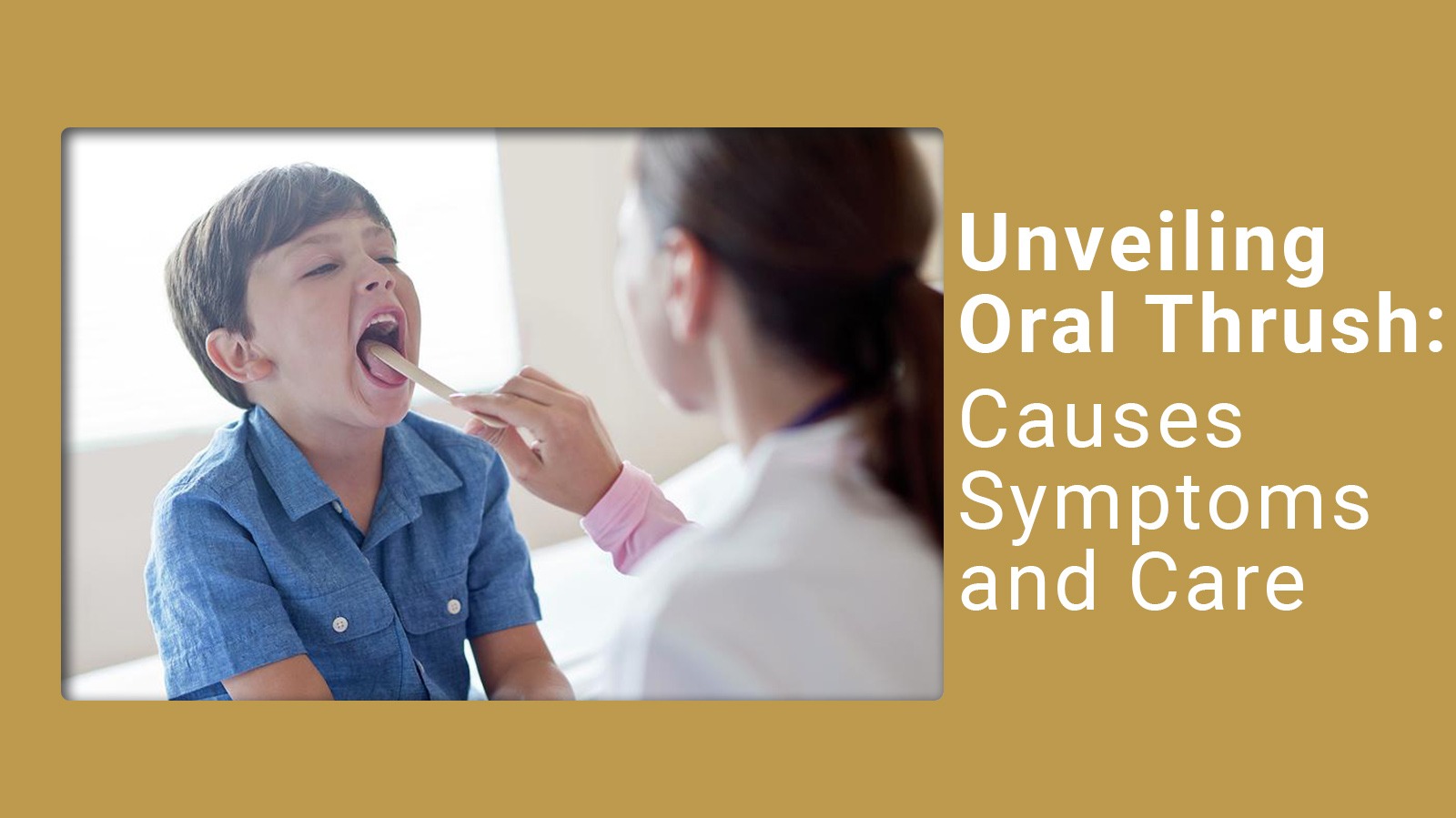Unveiling Oral Thrush: Causes, Symptoms, and Care

Oral thrush, medically known as candidiasis, is a common oral health issue that many individuals encounter at least once in their lifetime. Caused by the fungus Candida albicans, this condition manifests as creamy white patches on the tongue, inner cheeks, and sometimes on the roof of the mouth, tonsils, and back of the throat. While it’s commonly seen in infants and the elderly, especially denture users and those with compromised immune systems, it can affect anyone. This blog post aims to shed light on the causes and symptoms of oral thrush and provide valuable insights into its management. Whether you’re a patient seeking answers or a dental professional looking to enhance your knowledge, this guide will offer a comprehensive overview of this fungal infection of the mouth.

Causes of Oral Thrush
Oral thrush is primarily caused by an overgrowth of the fungus Candida albicans in the mouth. While this fungus is naturally present in the mouth and usually doesn’t cause any harm, certain conditions can trigger its overgrowth, leading to candidiasis. Here are some of the primary causes:
- Weakened Immune System: Individuals with a compromised immune system, such as those undergoing chemotherapy, taking immunosuppressant medications, or living with HIV/AIDS, are more susceptible to oral thrush.
- Medications: Certain medications, especially inhaled corticosteroids or broad-spectrum antibiotics, can disturb the natural balance of microorganisms in the mouth, promoting fungal growth.
- Health Conditions: Diabetes mellitus, especially when poorly controlled, can create an environment conducive to the growth of Candida. Other conditions like dry mouth can also contribute.
- Dentures: Improperly fitted dentures or not cleaning them regularly can provide a breeding ground for fungi.
- Other Factors: Smoking, hormonal changes during pregnancy, or excessive mouthwash use can also increase the risk of developing oral thrush.
Symptoms of Oral Thrush
Recognizing the symptoms of oral thrush is crucial for timely diagnosis and treatment. Some of the common signs include:
- White Patches: Creamy white lesions on the tongue, inner cheeks, and sometimes on the gums, tonsils, and roof of the mouth.
- Redness and Soreness: Affected areas may be painful and can bleed slightly when scraped.
- Cracking at Mouth Corners: Known as angular cheilitis, this can be a sign of candidiasis.
- Loss of Taste: Some individuals may experience a loss of taste or an unpleasant taste in the mouth.
- Difficulty Swallowing: In severe cases, especially oesophageal candidiasis, one might experience pain or difficulty swallowing.
Care and Management of Oral Thrush
Managing oral thrush effectively requires a combination of medical treatments and proactive oral hygiene practices. Here’s a comprehensive guide:
- Antifungal Treatment: The primary treatment for oral thrush is antifungal medication. These can be in the form of lozenges, tablets, or oral suspensions. It’s essential to follow the prescribed dosage and duration to ensure complete eradication of the fungus.
- Maintain Oral Hygiene: Regular and thorough oral hygiene practices can prevent the recurrence of oral thrush. This includes:
– Brushing: Using a soft-bristled toothbrush, ensure you brush at least twice a day. Consider products like the [Xpect Vision Intraoral Sensor](#) which can help monitor oral conditions effectively.
– Flossing: Daily flossing removes food particles and reduces fungal breeding grounds.
– Mouth Rinses: Avoid mouthwashes with a high alcohol content. Instead, opt for milder, antifungal mouth rinses.
- Denture Care: For those wearing dentures, it’s crucial to clean them daily. Remove them at night and soak them in a denture-cleaning solution. Ensure they fit properly to avoid any irritations. Products like Dental Sealing Machine can be beneficial for denture wearers.
- Dietary Adjustments: Reducing sugar and yeast-containing foods can help control the growth of Candida albicans. Probiotic foods like yogurt can restore the mouth’s natural balance.
- Regular Dental Check-ups: Regular visits to the dentist can help in the early detection and management of oral thrush. For dental professionals, using advanced equipment like the Trios 3 Color Pod Intraoral Scanner can provide detailed insights into oral conditions.

- Avoid Smoking: Smoking can increase the risk of oral thrush. If you smoke, consider seeking help to quit.

- Manage Health Conditions: If you have an underlying condition like diabetes, ensure it’s well-managed. Regular monitoring and medication adjustments can prevent oral complications.
What is Oral Thrush?
Oral thrush, medically termed “candidiasis,” is a condition characterized by the presence of creamy white lesions or patches in the mouth. These patches can appear on the tongue, inner cheeks, roof of the mouth, gums, tonsils, or back of the throat. At its core, oral thrush is caused by an overgrowth of Candida yeast, a fungus that naturally resides in our mouths in small amounts. Under normal circumstances, this yeast lives in harmony with other microorganisms in our mouth. However, certain factors can disrupt this balance, leading to an overgrowth of Candida and in the symptoms of oral thrush.
Risk Factors for Oral Thrush
While anyone can develop oral thrush, certain factors increase the risk of its occurrence:
- Weakened Immune System: Individuals with conditions that weaken the immune system, such as HIV/AIDS, are more susceptible. Similarly, treatments like chemotherapy or medications that suppress the immune response can increase the risk.
- Medications: Broad-spectrum antibiotics can kill beneficial bacteria in the mouth, allowing Candida to grow unchecked. Inhaled corticosteroids, often used for asthma, can also contribute if not used properly.
- Health Conditions: Uncontrolled diabetes creates a sugar-rich environment in the mouth, conducive to yeast growth. Dry mouth, either due to medications or conditions like Sjögren’s syndrome, can also be a factor.
- Dentures: Wearing dentures, especially if they aren’t cleaned regularly or don’t fit properly, can create areas where yeast can flourish.
- Age: Infants and the elderly are more likely to develop oral thrush due to immature or weakened immune systems.
- Pregnancy: Hormonal changes during pregnancy can disrupt the balance of microorganisms in the mouth.
- Smoking: Tobacco users are more likely to develop oral thrush compared to non-smokers.
Prevention of Oral Thrush
Preventing oral thrush involves addressing its risk factors:
- Oral Hygiene: Regular brushing, flossing, and rinsing with a salt solution can help maintain a healthy balance of microorganisms in the mouth. Products like the Xpect Vision Intraoral Sensor can assist in monitoring oral health.

- Denture Care: Clean dentures daily and remove them at night. Ensure they fit well to prevent irritation and potential yeast growth areas.
- Manage Health Conditions: Regularly monitor and manage conditions like diabetes. Adjust medications if they cause dry mouth.
- Limit Sugar Intake: A diet high in sugar can promote yeast growth. Reduce sugary foods and drinks, and maintain a balanced diet.
- Regular Dental Visits: Regular check-ups can detect early signs of oral thrush or other oral health issues.
Diagnosis and Complications
Diagnosing oral thrush typically begins with a thorough examination of the oral cavity. Healthcare professionals, especially dentists or oral pathologists, will inspect the mouth for the characteristic white lesions associated with candidiasis. They may also:
– Physical Examination: Check for the creamy white patches, and you may scrape off a sample to examine under a microscope. This helps in confirm the presence of Candida yeast.
– Endoscopic Examination: If there’s a suspicion that the infection has spread beyond the mouth, an endoscope—a long, thin tube with a light and camera—may be used to examine the throat and oesophagus.
– Throat Culture: In cases where the condition is severe or recurrent, a throat culture might be performed by swabbing the back of the throat and analysing the sample to determine the type of fungus causing the infection.
Importance of Proper Diagnosis
It’s crucial to seek a proper diagnosis for several reasons:
– Accurate Treatment: Proper identification ensures that the treatment prescribed is effective against the specific type of fungus causing the infection.
– Identification of Underlying Causes: A thorough diagnosis can help identify any underlying conditions or factors contributing to the overgrowth of Candida, allowing for more comprehensive treatment.
– Prevention of Complications: Early diagnosis and treatment can prevent potential complications and more severe infections.
Potential Complications
If left untreated, oral thrush can lead to more severe health issues:
– Oesophageal Candidiasis: One of the most concerning complications is the spread of the infection to the oesophagus, leading to oesophageal candidiasis. This condition can cause pain or difficulty swallowing and might even lead to a more systemic infection affecting other parts of the body.
– Systemic Candida Infection: In severe cases, especially in those with weakened immune systems, the infection can spread to other parts of the body, including the lungs, liver, and skin. This can be life-threatening and requires immediate medical attention.
– Increased Risk in Other Infections: An untreated oral thrush can make one more susceptible to other infections, especially in individuals with compromised immune systems.
Treatment and Management of Oral Thrush
Medical Treatments
Oral thrush, while uncomfortable, is treatable. Depending on the severity and the patient’s health status, healthcare professionals may prescribe:
- Antifungal Mouthwash: Nystatin is a common antifungal mouthwash used to treat oral candidiasis. It’s typically swished around the mouth and then swallowed or spat out.
- Antifungal Lozenges: These are dissolved in the mouth and are effective for milder cases of oral thrush.
- Antifungal Medications: For more severe cases or if the infection has spread beyond the mouth, antifungal medications like fluconazole might be prescribed.
Home Remedies and Lifestyle Changes
While medical treatments are primary, certain home remedies and lifestyle changes can support recovery and prevent recurrence:
- Saltwater Rinse: Gargling with salt water can help soothe the symptoms and maintain oral hygiene.
- Probiotics: Consuming probiotic-rich foods like yogurt can help restore the natural balance of bacteria in the mouth.
- Limit Sugar Intake: Reducing sugar in the diet can prevent the growth of Candida yeast.
- Good Oral Hygiene: Regular brushing, flossing, and changing toothbrushes frequently can prevent the buildup of fungi. Products like the Woodpecker DTE DPEX V Apex Locator can assist in maintaining optimal oral health.
Preventing Oral Thrush
Prevention is always better than cure, especially when it comes to conditions like oral thrush. By adopting certain practices and making lifestyle changes, one can significantly reduce the risk of developing or recurring this fungal infection:
- Good Oral Hygiene Practices:
– Regular Brushing and Flossing: Ensure you brush at least twice a day and floss daily to remove food particles and prevent the buildup of Candida yeast.
– Mouth Rinses: Use a mild, alcohol-free mouthwash to maintain a balanced oral environment. Overusing mouthwashes with high alcohol content can disrupt the natural flora of the mouth.
– Change Toothbrushes: Replace your toothbrush every 2-3 months or after an episode of oral thrush to prevent reinfection.
– Denture Care: If you wear dentures, clean them daily and ensure they fit properly. Remove them at night to allow your mouth to recover.
– A diet high in sugar provides a conducive environment for the growth of Candida yeast. Reducing sugary foods and drinks can help maintain a balanced oral environment.
- Managing Health Conditions:
– If you have underlying health conditions like diabetes, ensure they are well-managed. Regular monitoring and adherence to medications can prevent conditions that favor oral thrush.
– Stay hydrated to prevent dry mouth, another condition that can promote the growth of yeast.
- Avoiding Smoking and Excessive Alcohol:
– Smoking can disrupt the balance of bacteria and yeast in the mouth. If you smoke, consider seeking help to quit.
– Limit alcohol intake, especially beverages high in sugar, to maintain a healthy oral environment.
Special Considerations for Oral Thrush
Oral thrush can affect anyone, but certain populations are more susceptible due to specific factors associated with their age or condition. Here’s a closer look at these special considerations:
- Infants:
– Breastfeeding: Infants can contract oral thrush during delivery if the mother has a vaginal yeast infection. Additionally, if a breastfeeding mother has symptoms of thrush on her nipples, she can pass it back and forth with her baby. It’s essential for both mother and baby to be treated simultaneously to prevent recurrence.
– Pacifiers: Regularly sterilizing pacifiers can prevent the buildup of yeast and other harmful bacteria. If an infant has oral thrush, ensure that you sterilize all toys, pacifiers, and feeding equipment that come into contact with the baby’s mouth.
- Elderly Individuals:
– Denture Care: As mentioned earlier, improper denture care can be a significant factor in the development of oral thrush. Elderly individuals should ensure their dentures fit correctly to avoid areas where yeast can flourish. Daily cleaning and removing them at night can prevent yeast buildup. Products like Dental Sealing Machine can be beneficial for denture wearers.
– Immune System Changes: As we age, our immune system can become less effective in combating infections, including oral thrush. Regular health check-ups, a balanced diet, and proper oral care can help in maintaining a strong immune response.
Conclusion
Oral thrush, or candidiasis, is a common oral health condition caused by an overgrowth of the Candida yeast. While it can affect anyone, certain populations, like infants and the elderly are more susceptible due to specific factors associated with their age or condition. Recognizing the symptoms, understanding the causes, and being aware of the risk factors are crucial for timely diagnosis and treatment.
Good oral hygiene practices, limiting sugar intake, managing underlying health conditions, and avoiding smoking are some of the preventive measures one can adopt to ward off this fungal infection. Moreover, understanding when to seek professional help and the importance of early intervention can prevent complications and ensure a quicker recovery.
In the realm of oral health, knowledge is indeed power. By staying informed and proactive, we can ensure not only the health of our mouths but also our overall well-being. Remember, your mouth is a window to your body’s health. Prioritize its care, and don’t hesitate to seek timely professional advice when needed.


